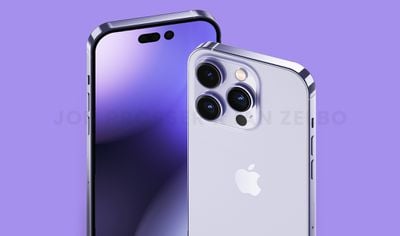The Pro models in Apple's soon-to-be-announced iPhone 14 series will feature a new Ultra Wide camera with a larger sensor for better low light sensitivity, but the technology will come at a significant cost increase, predicts respected analyst Ming-Chi Kuo.

In his latest tweet, Kuo says that the two iPhone 14 Pro models will have an Ultra Wide sensor with larger 1.4µm pixels compared to the previous generation Pro models. For reference, the iPhone 12 Pro and iPhone 13 Pro models all have a 1.0µm pixel pitch.
Practically speaking, the increased pixel size should result in improved light capture and decreased noise in low-light images, but the combined component costs – specifically the CMOS image (CIS) sensor, voice coil motor (VCM), and compact camera module (CCM) – will be up to 70% more expensive than those used in previous models.
According to Kuo, component suppliers Sony (CIS), Minebea (first VCM supplier), Largan (second supplier), and LG Innotek (CCM) will be "significant beneficiaries" of the Ultra Wide camera upgrade on the iPhone 14 Pro and iPhone 14 Pro Max models.
Kuo has previously said he expects more substantial improvements to the camera system on the iPhone 14 Pro devices, including a Sony-crafted 48-megapixel Wide camera to replace the current 12-megapixel Wide camera used in the iPhone 13 Pro and Pro Max.
With a higher number of megapixels, the Wide camera pixels will be smaller, allegedly measuring in at 1.22µm, a reduction of 0.68µm compared to prior-generation models. It will feature the same Dual Pixel Auto Focus system that Apple calls "Focus Pixels," and it will be able to record 16:9 video at up to 60 frames per second.
(3/4)
I predict two iPhone 14 Pro models' ultra-wide cameras will upgrade to 1.4µm (vs. iPhone 13 Pro's 1.0µm). CIS (CMOS image sensor), VCM (voice coil motor), and CCM (compact camera module) have a significant unit price increase in this upgrade, with about 70%, 45%, and 40%. — 郭明錤 (Ming-Chi Kuo) (@mingchikuo) August 30, 2022
Apple is rumored to be using a larger 1/1.3-inch sensor on the main Wide camera, offering a 21.2% increase over the 1/1.65-inch sensor in the iPhone 13 Pro models. Overall, the sensor area will increase by 57%, which is why we are expecting a larger camera array to accommodate the larger lens size.
The iPhone 14 Pro models will offer 48-megapixel and 12-megapixel photo output options, with the latter taking advantage of pixel binning. Pixel binning merges data from multiple smaller pixels on the camera's image sensor into a single super-pixel for better low-light sensitivity and performance.
Unfortunately, the 48-megapixel lens is going to be limited to the iPhone 14 Pro models, with standard iPhone 14 models expected to get a standard 12-megapixel camera lens that's similar in functionality to the 12-megapixel lens used in the iPhone 13 models.
However, Apple on the iPhone 13 Pro models introduced an improved six-element Ultra Wide lens with an improved ƒ/1.8 aperture, and these improvements are expected to come to the standard iPhone 14 models.
Apple will announce the new iPhones at its "Far Out" event on Wednesday, September 7. We're expecting to see a 6.1-inch iPhone 14, a 6.1-inch iPhone 14 Pro, a 6.7-inch iPhone 14 Max, and a 6.7-inch iPhone 14 Pro Max. Note that there will be no 5.4-inch iPhone 14 mini this year.























